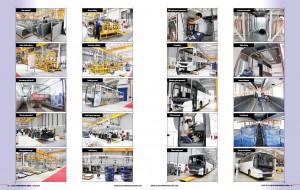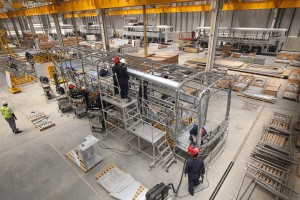Text : Anusha B
Swedish auto maker Scania, which started truck manufacturing operations at the Narasapura facility near Bangalore in October 2013, is now making use of “local talent and competence” by kick-starting the bus production in the country. Scania envisages the global technology standards in India as it does with other setups across globe with committed infrastructure and practices. Localisation is achieved in wherever-possible areas and the bottom line is to attract local competence and map the same with global standards.
The Narasapura facility can manufacture 1000 buses with 100% localisation in body material and 70% in overall bus value, the chassis has 30% local content. The company has around 50-60 vendors to supply components for the buses. Scania has started localising body parts of buses and the indigenisation has been achieved by sourcing tyres, electrical aided components with batteries and other related components which comprise the body parts. Critical components like gear box, engines and axles are getting imported. They also look out for making these components too indigenously but the Indian standards does have a subtle changes against global. As Scania is developing global buses there are some contradicting calibrations involved with respect to Indian buses and hence it has become imperative to import these components outside India. The differences are now attended and soon India will flag its 100% localisation.
The chassis frames are different for buses and commercial vehicles but the platform in which it gets manufactured and the components are the same. Unless Scania achieves voluminous business in terms of number of units the engine manufacturing could not be localised. But it envisions lime light in Indian market as it becomes the hot spot location-wise and source-wise for exporting. By 2017 Scania is planning to augment its production from 1000 to 2000 units of buses and from 2500 to 5000 trucks signing a huge scale of employability.
Scania Bus Plant
The manufacturing facility is now commissioning 2 models, 13.7 and 14.5 with 268 employees which includes women strength of 26%. One shift operation is off the mark now and number of shifts will increase gradually when full swing operations are in place. The global buses are featured with updated technologies and imparting these technologies to the existing work force consumes 90% of production hours last year till December and fine tuning is still in the cards. Manufacturing buses promoting green mission are also in the purview-palette and lot of rejig with respect to manufacturing queued up. Galvanising process to highlight withstands buses during adverse weather conditions and this serves as an additional protection. They are in the vigorous move of structuring ethanol buses which support Green Mission and all process for the same are set in place. The lead time for assembling buses in various stations is 12 hours and the time will get reduced to 10 hours, 8 hours, 6 hours, 4 hours subsequently. This could be realised with increased work force and infrastructure facilities.
Structure Manufacturing
To manufacture the entire body shell it undergoes 4 stations, where the different types of tubes are welded in a sequence. According to the specification the jigs are placed and the tubes are fixed in the jigs and welded together to form a side and roof portion of a shell. In each stage different types of welding is done and finally sent to structure paint booth. Here the entire structure is painted manually to avoid rust and to enhance the quality. This painted structure then undergoes for sealing process, where a coating is made to hold the adhesive.
Assembly
In parallel the chassis that are assembled in the chassis shop is brought to the bus assembly line. The marriage between chassis and the structure takes place in the assembly station 01. Here the structure is dropped over the chassis precisely and made sure it is properly aligned. Once it is done the entire structure is moved to the station 02, where all the wiring harness and other cables are laided out. To lay the cables more than 4 people were engaged due to complexity of the wires and all the wires are connected to a central junction. Once it is done the flooring is done with the plywood, which is fire resistant. On the other side the panels for the entire bus is sourced and cut according to the specification. Later the shapely cut panels are fitted with special adhesives to stay strong.
To avoid fire accidents, the company has designed the fuel tank in such a way and placed it near the luggage compartment next to rear tyres. After the panels are fixed completely, rest of the cables and wires are connected including the steering column. In the assembly station 05, the plastic components and flooring mats are laid out. The final shaping of the bus is carried out in the assembly station 06,07,08,09 and 10. In station 06 the window glasses are fixed and inner luggage storage is fixed. Station 07 is commissioned for interior finishing, the front parts of the bus are assembled here. This again takes it immediate ascend station 08 and here the seats are placed and fitted with the necessary fittings. Along with that the mandate electrical activities with respect to buses are disciplined here.
Testing
The station 09 takes care of the sticker assembly. In addition to that fire extinguisher installation, fitness check are controlled here. This station gives a ready look for the buses. Station 10 is considered as the nascent stage of the bus and in this station manual movement of the vehicle is done. The bus is filled with power drain oil, diesel and coolants for a trial move. Once it is done, wheel alignment is carried out in this station along with that brake testing and head lamp testings are done to ensure fittings are embracing the international standards.
As the vehicle is fully built, the bus undergoes shower testing to identify leakages and other malfunctions. These different testing methodologies ensure quality of the bus in unfavorable conditions. Before rolling out the buses, Bus Body Manual Quality (BBMQ) assurance is checked and calibrated. Once it is done the fully built bus comes to the roll out stage where the consolidation, validation and declaration of the vehicle to the consumer is carried out and finally delivered to the customers.
Scania’s localisation commitment
Scania is planning to localise 100% in very near future. The chassis part which is getting imported from Sweden paves an important role in delivery getting slightly delayed from the purchase proposal. This is mainly due to the chassis which is ordered in Sweden post receiving purchase order in India and subsequently build the same. Hence from the date of purchase proposal it incurs at least 6 months to get the bus delivered to the consumer. To mitigate all these locomotive issues Scania is planning to localise 100% in the near future and hoping the manufacturing segments in India will support the global bus model chassis and support international standards.
Scania is introducing 2 more models by the end of 2015 and one of those models is highlighted as 12 metre low entry bus which will soon hit the roads. To underscore this bus would run with ethanol fuel supporting green mission. Scania’s promise of delivering sustainable transport solutions in India takes a major step forward with the bus manufacturing plant. The plant will house a bio-gas production unit and will locally assemble ethanol buses. The company will also broaden the scope for manufacturing more products powered by alternative fuels, which will catalyse sustainable development in India to a whole new level.
INTERACTION: Klas Dahlberg, Senior Vice President, Buses & Coaches, Scania Group
Q: What is the current plant capacity and future plans?
Klas: The current plant capacity with existing work bench, infrastructure and work force at Narasapura we could scale our production and deliver upto 675 units. We are planning to increase the production to 1000 units by this year end. The production will almost be doubled translating our mission of manufacturing 2000 buses and 5000 trucks by 2017. Processes are queued in place to achieve the figure and fine tuning with a strategic move will help us to realise this zeal.
Q: What is the current level of localisation and what are all your future plans?
Klas: We are almost 70% localised when it comes to body parts of the bus. But indigenisation has not been achieved 100%. Critical components like gear box, engines and axles are getting imported. We still have challenges in localising these critical components as Indian standards reflect minute changes but once the international standards are in place we will try to achieve 100%.
Q: Currently with how many vendors you have tied up?
Klas: We have 50-60 vendors supplying components predominantly for body parts.
Q: Will you use the same frames for both buses and trucks?
Klas: We would not be using the same frames for both buses and trucks. The platform is same, components are same but the frames are different. So we could stage manage components but bespoke frames should be in place.
Q: What is the lead time to manufacture a bus?
Klas: The lead time for assembling buses in various stations is 12 hours and the time will get reduced to 10 hours, 8 hours, 6 hours, 4 hours subsequently. This could be realised with increased work force and infra facilities.
– Bhargav TS
















